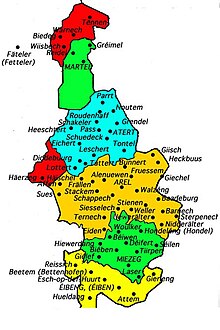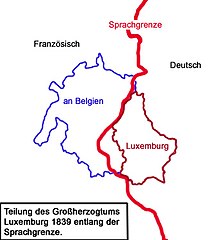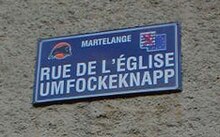Areler Land
As Arelerland ( Luxembourgish Arelerland , French Pays d'Arlon ), sometimes even as Old Belgium-South called, is a multilingual border region in the southeast of Belgium in the province of Luxembourg referred. It borders on the Grand Duchy of Luxembourg and officially belongs to the French Community of Belgium, but Moselle Franconian has also been spoken in the region from time immemorial .
Demarcation
In a narrower sense, the Areler Land has consisted of five municipalities since the Belgian regional reform in 1977 :
| official name (French) | Luxembourgish name | German name |
|---|---|---|
| Arlon | Arel | Arel |
| Attert | Atert | Attert |
| Aubange | Éibeng | Ibingen |
| Martelange | Maartel | Martelingen |
| Messancy | Miezeg | Metzig |
In total, these five communities have around 60,000 inhabitants. In addition, the district of Herzig (French Hachy , Luxembourgish Häerzeg ) of the otherwise French-speaking community of Habay as the westernmost place with German dialect (Luxembourg dictionary, volume 2) and the district of Tintingen (French Tintange , Luxembourgish Tënnen ) of the otherwise French-speaking community of Fauvillers traditionally belong to the German (or more precisely to the Moselle Franconian-Luxembourgish) language area.
history
The Areler Land has belonged to Belgium since 1830. It is therefore - in contrast to the area around Eupen , Sankt Vith and Malmedy , which only came to Belgium in 1919/20, which was previously called New Belgium - sometimes referred to as Altbelgien-Süd. The Low German communities further north, which have also belonged to Belgium since 1830, are defined as Old Belgium North according to this approach. (The designations Altbelgien-Nord and -Süd as well as New Belgium are limited to areas in which German dialects were spoken. The Belgian heartland was never referred to with these terms, which are rarely used today.)
When Luxembourg was partitioned in 1839, which mostly ran along the German-French language border, the Arel region fell to Belgium despite its German-speaking population. This was due, on the one hand, to the lack of a larger city on the Belgian side, which could have fulfilled the function of an administrative capital in the new Belgian province of Luxembourg , and, on the other hand, to France's claim to build the strategically important road from the French Longwy via Arel / Arlon and Bastogne (Bastnach ) to be added to the neutral Belgian state after Liège or Brussels and not to the Grand Duchy of Luxembourg, which remained part of the German Confederation (until 1866). After that, French was introduced as the administrative language and French-speaking workers from other parts of Belgium were settled in Arlon. School lessons increasingly took place in French; in the city of Arlon it was held exclusively in French from 1870 onwards, and the German language was held in rural schools until the First World War . In order to counteract the decline of the German language, the historian Godefroid Kurth first founded the “Association for the Care and Improvement of the German Mother Tongue in German-speaking Belgium” in Arlon in 1893 and finally in 1905 the German studies specialist Heinrich Bischoff founded the “German Association for the Province of Liège “Based in Montzen and the Schiller Society in Liège.
As a result of the invasion of German troops in 1914, strong anti-German feelings arose. As a sign of Belgian patriotism, German was largely replaced by French in public areas after the war. In the private sphere, however, the traditional dialect still held up for the time being. Once again Bischoff tried together with the socialist MP Marc Somerhausen (1899-1992) and the pastor Frédéric Schaul in 1931 by founding the "Bund der Deutsch-Belgier" in the Luxembourg community of Tüntingen , which was the successor organization to the " Association for the maintenance and uplifting of the German mother tongue in German-speaking Belgium "saw to revive the German language and to re-establish it as the main language in school lessons. However, since the population in these communities was consolidated in their Belgian-national attitude and was also deterred by the incipient nationalist currents in Germany, the federation founded by Bischoff met with increasing unacceptance as early as 1933 and later became meaningless.
Nevertheless, during the Second World War, the German occupiers tried to introduce German as the only official and school language in the Arel region. After the end of the war, a strong antipathy against German and its consequent suppression by French were the result. Many citizens of the area switched to French more and more often in their private lives. In 1948 German was abolished in primary schools in the Areler Land and French was introduced as the only church language. In 1963, the Areler Land was assigned to the francophone language area by defining the language borders without linguistic minority rights ( facilities ).
After the Grand Duchy of Luxembourg began to develop Luxembourgish into the standard language, also in response to the German occupation, the ALAS ( Areler Land a Sprooch ) association was founded in Areler Land in 1976 . This aims to have Luxembourgish recognized as the second official and school language in the area. In 1990 the French Community of Belgium recognized all languages and dialects spoken in its territory besides French as minority languages. Since then, many road and place-name signs in the Areler Land are bilingual (French and Luxembourgish). A bilingual kindergarten was set up in Messancy in 1992, but there are no facilities to regulate the use of the minority language; French is still the only official and school language in the Areler Land.
In the meantime, the greater part of the population in and around Arlon is exclusively French-speaking, even in private. Since there are not enough jobs locally, many residents of the area work in the Grand Duchy of Luxembourg, and so the importance of Luxembourgish for the population of the Areler Land has increased in recent years. Nevertheless, the proportion of German or Luxembourgish speakers in the Arel region is classified as lower than the proportion of the Germanic-speaking population in the Low German municipalities in the province of Liège , which, however, are among the municipalities with minority rights. The German-speaking Community (DG) in the province of Liège only includes areas where the majority of the population is German-speaking.
See also
Individual evidence
- ^ Hans Goebl, Peter H. Nelde, Zdenek Stary, Wolfgang Wölck (1997): Kontaktlinguistik / Contact Linguistics / Linguistique de contact . ( google preview )
- ↑ Johannes Kramer, 1984: Bilingualism in the Benelux countries . ( google preview )
- ↑ Johannes Kramer, 1984: Bilingualism in the Benelux countries . ( google preview )
Coordinates: 49 ° 40 ' N , 5 ° 46' E





